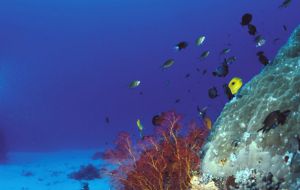MercoPress. South Atlantic News Agency
Teeming biodiversity in ocean volcanoes off SE Australia
 Hundreds of ancient marine species and corals have been found off Australia's south coast
Hundreds of ancient marine species and corals have been found off Australia's south coast CSIRO's Wealth from Oceans Flagship team has discovered hundreds of new marine species and dozens of undersea mountains, in a project to monitor the Commonwealth Marine Reserve Network off southern Tasmania.
CSIRO is Australia's Commonwealth Scientific and Industrial Research Organisation. The remarkable findings were made during surveys of the Tasman Fracture and Huon Commonwealth Marine Reserves, about 100 nautical miles off the coast of southern Tasmania. The project is collaboration with the Department of Environment, Water, Heritage & the Arts. It aims to provide inventories of biodiversity and habitats, and develop operational detail for ongoing monitoring of the network. Scientists from CSIRO worked with colleagues from: Geoscience Australia; Museum Victoria; the Queensland Museum the Australian Museum. The team analysed the findings, which include an incredible 274 species new to science and a further 80 seamounts, or undersea mountains, which are some of the most biologically important habitats in our oceans. This research was conducted in just two of the 14 reserves that form part of the network. Most of these seamounts are cone-shaped remnants of extinct volcanoes. They can be up to 25 kilometres across at the base and rise 200 to 500 metres from the seabed. They provide hard, elevated and current-swept habitats for rich communities of filter-feeding corals and sponges on the predominantly flat and muddy floor of the deep sea. Data from this marine research project came from two surveys undertaken on the Marine National Facility Vessel, the Research Vessel Southern Surveyor – using multibeam sonar and underwater video transects, as well as seafloor sampling in November 2006 and April 2007. In total, 274 species new to science were brought to the surface and analysed, along with 86 species previously unknown in Australian waters and 242 previously studied species. The sophisticated sonar equipment onboard also discovered 80 previously unknown seamounts, raising the total in the region to at least 144, which is easily the highest concentration in Australian waters. Scientists also discovered 145 new undersea canyons, raising the regional total to at least 276. The richness of mollusc fauna found, such as snails, squid and octopus-type creatures, has been described by marine scientists as 'astounding' and requiring a complete rewrite of textbooks for this type of fauna.




Top Comments
Disclaimer & comment rulesCommenting for this story is now closed.
If you have a Facebook account, become a fan and comment on our Facebook Page!